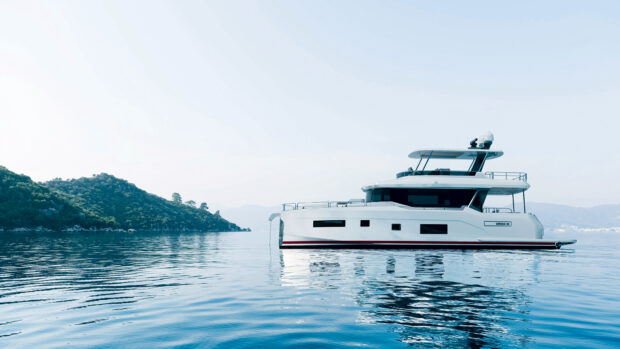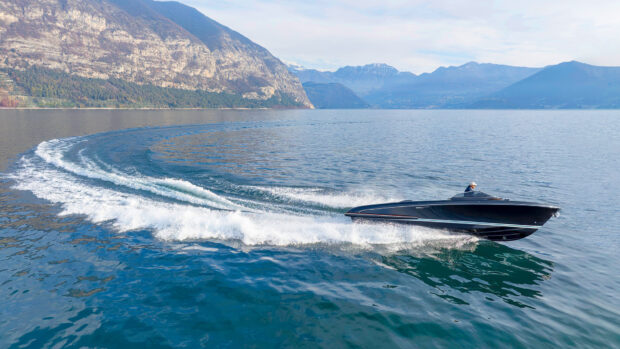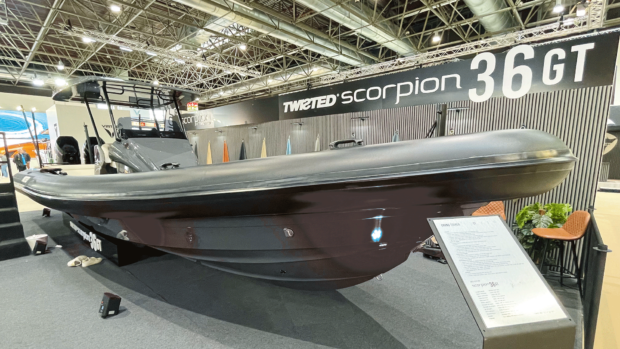The return of boat shows confirmed that there has never been so much choice if you want an electric boat, but are manufacturers, marinas and consumers ready to embrace an electric future?
What was clear from the autumn boat shows is that the electrification of motorboats is not future technology that is 10 years down the line, it is happening right now. From 25ft 3in (7.7m) foiling sportboats to 59ft 1in (18m) catamarans, electric boats are here and they are here to stay.
Lower volume shipyards have led the way with the likes of Rand, X Shore and Frauscher proving that an electric alternative is possible but it’s striking that some of the mainstream giants of the industry are now picking up the mantle.
For example, at the Cannes boat show, the Beneteau Group announced that the Delphia range, which it acquired in 2018, will be fully electric by 2024 with the first all-electric models hitting the water in 2022.
Greenline Yachts is the most established builder of all-electric boats in the sector but it’s telling that in 2020 just 10% of its production comprised pure electric boats.
“Building heavy mid-size cabin cruisers puts us in a difficult position,” explains Luca Raumland, Head of Sales and Marketing at Greenline’s parent company, SVP Yachts, “as the expectation of the customer is so much higher than what is possible at the moment.
“There aren’t many buyers who are willing to part ways with the money you need to buy a 30-40ft cabin cruiser that can only do 10 knots.
“Of course, we could build a Greenline 40 that can do 22 knots for 100nm but that would involve two 200kW electric motors and a mountain of batteries so the cost would be equivalent to that of a diesel-powered boat of 60ft or more – it’s a hard sell.”
Plug and play
In the short term, it’s small day boats that are the most viable converts to electric power and there are a couple of British brands leading the charge (no pun intended).

From small RIBs to big catamarans, the variety of electric boats on the market is growing
RS, prolific producers of sailing dinghies for racing and recreation, unveiled its Pulse 63 electric RIB at the Southampton Boat Show and has ambitions to produce 1,000 electric boats annually across a range of models within five years.
RS is renowned for its light and efficient dinghies and that expertise was crucial in producing the Pulse, a 20ft 7in (6.3m) RIB with a top speed of 23 knots and 40+nm range at 15 knots priced at around £80,000.
Jon Partridge, Commercial CEO of RS RIBs, believes that the phrase of choice for electric boat builders going forward will be “enjoy the journey”.
Article continues below…

Electric boats: A-Z of the 37 best all-electric models

Eegle 20m first look: World’s first electric trawler yacht takes on diesel rivals
“We think there will be a shift in attitude from owners of small sportsboats from travelling at 30-40 knots to cruising at 15-25 knots,” he says.
“Going 40 knots in a motorboat is pretty uncomfortable for the majority of people and we are seeing a change in mentality from top speed to comfortable cruising where you can use the boat when it’s on the move.”
Vita is another company based in the UK, founded in 2017 by financial technology entrepreneur Stewart Wilkinson after he failed to find an electric motorboat on the market that suited his needs.
As well as electric boat production, Wilkinson is also investing heavily in the infrastructure network through his other company Aqua Superpower, which has installed a handful of high capacity (up to 150kw) superchargers along the Cote d’Azur and Italian coastline.
The company was recently awarded a grant to install five chargers on sites within Plymouth Sound between now and March 2022.
It plans to install 15 more chargers in Europe by the end of 2021 with a further 120 going into the ground next year, though at £100,000 per unit the cost is prohibitive and there is some scepticism from marina operators that this is still tomorrow’s technology.

It costs £100,000 to install one Aqua Superpower charger
“Unless people see a real infrastructure in place they will not take that leap of faith and transition to all-electric,” says Alex Bamberg, CEO of Aqua Superpower.
He should know, given he’s worked in sustainable energy for 20 years and was one of the architects of the electrification of the UK’s highways in a previous life at ChargePoint.
“At the Cannes Boat Show in 2019 there were 65 orders for pure electric boats; at the one just gone there were more than 600,” he adds.

Modern battery packs should last 3,000 charge cycles, equivalent to 35 years of typical boat use
“Things are going in the right direction but when it comes to the marine charging infrastructure there are some nuances compared to the road network.
“Boating is a seasonal pastime and this creates a unique challenge for the network, as does the marine environment, which is much tougher on the hardware.
“All of our chargers are marinised, IP65 rated and have no live current until an “electric handshake” has been made between the boat and charger when the plug is connected.”
Electric infrastructure
Bamberg envisages a Tesla-style web of superchargers where, in ideal circumstances, the charger recognises the boat and begins charging with payment made through a prepaid account so the user needn’t brandish a smartphone or RFID card.
Aqua Superpower’s network is currently free to use but payment will be introduced next year when users will be able to pay via a dedicated smartphone app or contactless payment on the charging station.
“This is a much warmer space to transition into electric boats than the automotive world of five or six years ago,” he says.

Motor and battery technology is improving – and getting cheaper – all the time
“There is less pressure to dash-and-go in the boating world and cars have done a good job of reducing range anxiety but there lacks a joined-up, reliable corridor of charging to give people the confidence to use their boats the normal way at this stage, and that is a crucial element.”
Of course, the difference between boaters and car drivers is that many boat owners are used to plugging into shore power at the end of the day so the notion of having to connect to a charger isn’t viewed as an inconvenience – it’s part of life. The RS Pulse 63 will charge overnight via a standard 16A shore power connection and with a £10,000 25kW charger could be ready to go again in under two hours.
This may not be viable for larger craft with bigger battery banks, so superchargers will play a big role going forward, but the current marine infrastructure is primed for electrification.
Will there be a ‘Tesla moment’ in the boat world? If there is, it’s highly likely that it will come from Candela, a Swedish company that has taken an entirely different approach to building an electric boat.
Its engineers deduced that in order to make the energy produced by the battery pack last as long as possible, weight and friction had to be significantly reduced. The Candela C-7, with its carbon-fibre structure and integrated computer controlled hydrofoils, was the answer– a 25ft 3in (7.7m) sportsboat with a range of 50nm at 22 knots.
“People were waiting for this moment,” says Candela’s Marketing and Communications Manager, Mikael Mahlberg. “Most of our customers are already invested in the electric sphere in some shape or form; many are Tesla owners and early adopters of new technology. We are seeing a new breed of boat buyer commit to the brand, many of whom have never owned a boat before.”
Grand designs
In the wake of Candela announcing the new C-8 it sold 60 boats in the first four weeks off plans alone, and Mahlberg believes it is in the top two or three best-selling 28-footers in Scandinavia already. All the more impressive when you consider that at €290,000 it is over €100,000 more expensive than an Axopar 28.
Candela has big plans, including a 40ft foiling passenger ferry for Stockholm that could feasibly be extrapolated to a 150-passenger transport vessel. This bodes well for the recreational sector where this technology could be adapted to create a large leisure boat.
“We will absolutely build a bigger boat,” Mahlberg insists, “a recreational boat of 50-60ft is certainly possible and, at the other end of the scale, we think we will be able to build a €50,000 boat as the technology becomes more affordable.”
This is a key point – battery and powertrain technology is still relatively new and heavily reliant on development in the auto industry. Battery tech is improving at a rapid rate with costs and weight coming down and density, cooling efficiency and end of life solutions all improving.

Greenline Yachts now offers its entire range in diesel, hybrid or all-electric versions
Vita reckons the batteries on the LION can go through 3,000 charging cycles (approximately 35 years of boating under normal seasonal use) after which they could be removed and used as energy storage at the company’s manufacturing facility, for example.
Mahlberg adds: “If we look ten years from now we’ll see a lot of changes in the leisure boat industry and I think electric boats will develop in two ways: conventional sportsboats and cabin cruisers will be replaced by foiling electric boats, built either by new companies or existing brands that have bought in to foiling technology, and the electrification of displacement boats.
“There may be a certain percentage of conventional fast planing boats with electric power trains but that will be a niche market as they are likely to be very expensive.”
The shift to sustainability
Look no further than Silent Yachts as proof that the electrification of displacement craft is a key component of this industry shift.
In theory, its electric catamarans have limitless range in the right conditions as their vast array of solar panels harness the sun’s energy and use it to fuel the battery bank without the need to plug into a shore socket.
The natural efficiency of a catamaran’s slender hulls make it an ideal platform for electric propulsion and, as I can attest having lived on board one for a few days, it really works.
The brand’s latest model, the Silent 60, has a 286kWh lithium battery pack and a pair of 340kW electric motors for a top speed of 20 knots. This is real-world technology that is available to buy now, albeit for €2.18m.
The industry has a duty to segue to a more sustainable model for motorboats, not just to temper its own footprint on the planet but to future proof itself in line with the next generation of owners who will be more conscious of the environment.
As Alex Bamberg from Aqua Superpower points out: “It used to be a statement to turn up in central London in a Range Rover, now it’s those turning up in a Tesla Model X that are making the statement.”

There are still many hurdles to overcome to cement electric boats as a true alternative to traditionally powered motorboats.
The marine industry is at the beginning of what will be a challenging journey but it’s crucial for boatmakers’ own health – and more pertinently the health of the planet – that it’s one that continues at pace.
First published in the December 2021 issue of MBY.
If you enjoyed this…
Be first to all the latest boats, gadgets, cruising ideas, buying advice and readers’ adventures with a subscription to Motor Boat & Yachting. Available in both print and digital formats, our monthly magazine will be sent directly to your home or device at a substantial discount to the usual cover price. See our latest offers and save at least 30% off the cover price.










